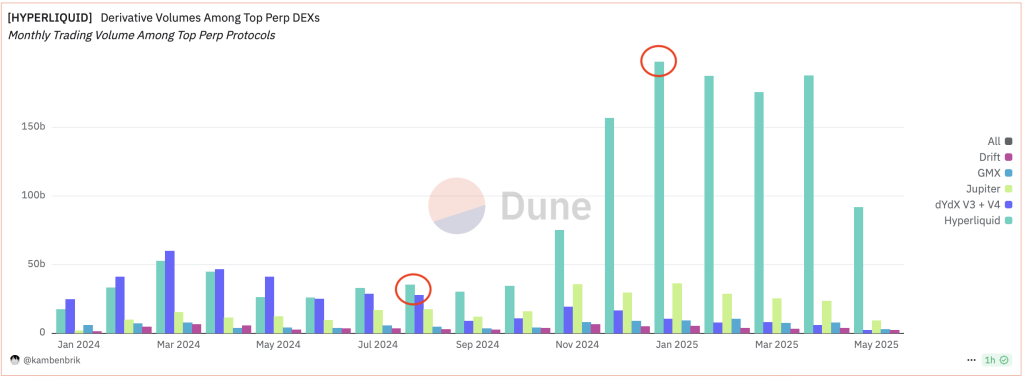Hyperliquid’s Valuation Sparks Debate: ’Market Missing the Bigger Picture’
Crypto analysts are sounding the alarm—Hyperliquid’s current price barely scratches the surface of its potential. With institutional interest quietly building, the protocol’s bleeding-edge infrastructure could flip the script on decentralized derivatives.
Why the disconnect? Blame the usual suspects: short-term traders chasing memecoins while real innovation trades at a discount. One quant firm claims Hyperliquid’s order book efficiency alone justifies a 3x re-rating—if anyone’s paying attention between degen trades.
Meanwhile, traditional finance still can’t tell an L1 from an ETF. Their loss.
 Source: Dune
Source: Dune
So what’s behind the breakout?,at LiamonBros, says the growth is more than hype. He points to Hyperliquid’s 61% market share and daily volume above $6 billion. “They’ve become the undisputed leader in decentralized perpetuals in record time. The market has to respect that,” he told Cryptonews.
JELLY Incident: Scandal or Stress Test?
In late March, Hyperliquid found itself in the spotlight after a scheme involving the Jelly-my-Jelly (JELLY) token. On March 26, an unknown trader used a strategy to drain the Hyperliquid Vault (HLP) by opening massive short and long positions. The MOVE caused sharp volatility in the price of JELLY and nearly pushed the vault to the edge.
Had the price dropped any further, the HLP could have been wiped out. That scenario did not play out. Instead, Hyperliquid stepped in and removed JELLY from its futures markets. The decision immediately raised questions about how decentralized the protocol actually is.
Many expected the incident to hurt the platform’s reputation. But according to Daniil Kozin, the opposite happened. Key metrics suggest the event brought more users in rather than driving them away. Daily active traders jumped from 28,500 to 34,800. Liquidity provider APY ROSE from 18.6% to 23.4%. Daily trading volume also climbed, reaching $7.1 billion shortly after the event.
“It attracted more users by demonstrating they can handle crisis situations effectively,” Kozin told Cryptonews.
The incident sparked a broader debate about decentralization in crypto, but the damage to Hyperliquid’s image seems limited. In practice, most traders appear to care more about performance than governance models. They tend to stick with what works.
According to DeFiLlama, Hyperliquid’s applications, where the exchange accounts for the majority of activity, brought in $43.15 million in revenue over the past 30 days. That figure remained stable after the JELLY event. At the same time, the platform’s Total Value Locked (TVL) grew by 111% in a month and reached $1.035 billion at the time of writing.
For comparison, Jupiter, another major player in DeFi, posted much lower numbers. In April, its revenue came close to $2 million only once, although its TVL has also been growing steadily.
If Hyperliquid Leads Among DEXs, Where Does That Leave Binance?
While Hyperliquid is gaining ground in decentralized markets (DeFi), Binance remains its closest rival in perpetual futures trading. Despite being a centralized exchange, Binance is still one of the most recognized platforms in the space.
Its dominance is clear from the numbers. According to CoinPaprika, Binance averaged around $70 billion in monthly perpetual futures volume over the past 30 days.
Kozin points to a key shift:
The fact that 68% of new users are coming from traditional CEX platforms shows this isn’t just crypto natives speculating.
This becomes more notable in light of speculation surrounding the JELLY incident. Some researchers suggest that the trader behind the scheme may have had links to Binance and was trying to harm a rising competitor.
Whether this marks a broader shift away from centralized platforms is hard to say. Kozin believes the debate around centralization often misses the nuance:
This criticism misses the point entirely. We shouldn’t fall into extremes. I don’t believe in 100% centralization or 100% decentralization.
In his view, the ideal setup is a hybrid model that combines the advantages of both approaches:
The ideal product is a hybrid model combining the strengths of both approaches.
He argues that Hyperliquid is already heading in that direction. The platform offers on-chain order books, self-custody, and open governance while still keeping the user experience smooth.
Looking ahead, Kozin says Hyperliquid is facing another stress test. A whale recently opened a $2 million short position on HYPE, with liquidation set at $27.5. “The recent whale shorting 2 million HYPE tokens (with liquidation at $27.5) presents an interesting test case,” he says. “How Hyperliquid handles potential liquidation of such a massive position will be crucial.”
Kozin warns that transparency will play a key role:
They need proactive communication about their strategy.
“Whether the vault absorbs the position or triggers a market-order liquidation,” he notes, “could have dramatic effects on both price and confidence.”
At the same time, Kozin underscores the protocol’s financial position. Hyperliquid has collected over $300 million in fees this year, runs daily buybacks worth $1.25 million, and maintains an assistance fund holding 21 million HYPE (valued at around $400 million). Despite the platform’s scale, there are still only 100,000 holders:
Strong fundamentals, proven crisis management, and sustainable tokenomics suggest HYPE is significantly undervalued at current levels.

